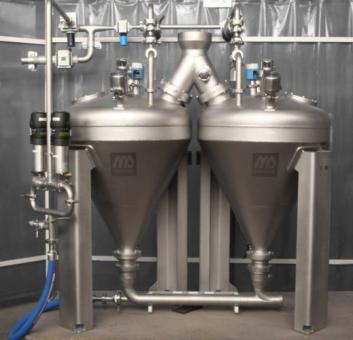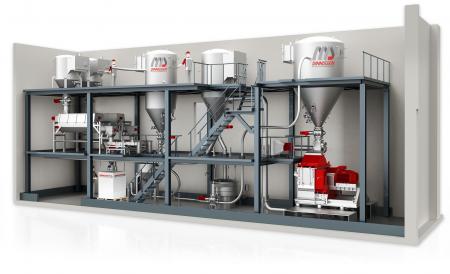This article discusses:
- The effect of dense phase conveying
- The operation of dilute phase conveying
- The two different forms of dense phase conveying
The experts at Dinnissen Process Technology are available to answer all your questions:
Get in touch with Juul Jenneskens 077 467 3555
Dense phase Transport
With Dense Phase Transport a dense mass of product is passed through the transport system. The ratio of air to powder is very small. Dense Phase Transport is characterized by a relatively high pressure (approx. 5 Bar) and a low flow velocity (up to 5 m / s) of the product to be transported.
Dense Phase Transport is ideal for transporting delicate and abrasive powders. This is possible with a vacuum system as well as an overpressure system. The vacuum system is mainly for shorter distances, while overpressure is used for longer distances. The distance over which the powder can be transported depends on the properties of the powder. Longer journeys have a greater risk of congestion. Especially with wetter and fattier powders, the system will silt up if the distance to be transported is too great. This is taken into account in the design of a Dense Phase Transport. For example, it is possible to gradually install air injectors in the system that counteract clogging.
The reason for the low speed is to damage the product to be transported as little as possible and / or not to damage the system. With Dense Phase Transport it is necessary to always have enough supply of the product. If the supply is too low, the Dense Phase Transport will change into dune or air transport. The danger is that damage is caused to the powder to be transported or the system

Dense phase transport
Dilute phase
Dilute Phase conveying is simply the opposite of Dense Phase Transport. With dilute conveying, the product to be transported is blown through the system. In principle, all particles can be transported pneumatically as long as sufficient air is available to distribute the particles over the air-particle mixture. The ratio of air to powder is high. High flow velocities (from 11 m / s to 16 m / s, depending on product properties) must be achieved at a low pressure (approx. 1 bar). The majority of the particles are kept in the air and particles that fall down are quickly taken back into the air flow. The particle size, bulk density and particle shape are important for the required air speed. A leaf from a tree will also blow away faster in the wind than dust particles on the street. Air transport is especially important for powders that can clump when transported under pressure. In general, the solids loading ratio should be around 15 for Air Transport. If the pipework is shorter and a higher pressure is used, this can increase further.
Air transport can be realized with a vacuum as well as with overpressure. Both systems are widely used and many different products can be transported with them. The distance over which flight transport is realized is completely dependent on the powder and the power of the system. It is imperative that the powder continues to fly and does not settle during transportation. This will cause congestion.
With Air Transport, the product gets a lot of impacts during transport. That is why fragile powders cannot be transported by air transport. In addition, the system itself will suffer more damage due to the abrasive effect of the powder. For this reason, Air Transport is not a good choice for abrasive powders.
Additional air injectors are not used for Air Transport. This is not necessary because there is enough pressure in the system to transport the product. In addition, extra air injectors for Air Transport will cause turbulent transport, which will make the flow worse. Air-injectors therefore have no advantages in air transport, not even to prevent powder precipitation. Precipitation can be prevented by creating a higher air pressure in the system, shortening the distance or by increasing the mixing ratio.

Dilute phase transport
it is possible to gradually install air injectors in the system that will prevent clogging
The two forms of dense phase conveying
There are two types of dense phase conveying:
- pulse conveying
- dune flow
With pulse conveying, a dense mass of product is alternately guided through the transport system with air. This creates a system in which plugs of powder are transported in a controlled manner. A characteristic of pulse conveying is a low flow velocity (approx. 6 m / s) at a lower pressure (approx. 3 Bar) compared to Dense Phase Transport. The reason for this is the relative mixing ratio of air to product. Plug Transport is used for the same types of powders as Dense Phase Transport is used for. However, with Plug Transport, it must be taken into account that a small part of the product mixes with the air between the plugs. That powder will damage during transportation. Plugging Transport can be realized with a vacuum or overpressure system. Experience shows that with a vacuum system the plugs maintain themselves better than with overpressure systems. A clear explanation cannot be given for this. In tests it appears that the overpressure causes too great a relative speed difference between the powder particles. This allows the top of the plug to be blown away, causing the entire plug to collapse. The Proppen Transport then changes into a Duinen Transport. Just like with air transport, there are no options for extra air injectors at Proppen Transport. These will cause the wads to fall apart, turning it into a Dunes Transport.
Another form of Dense Phase Transport is Duinen Transport, a transport type that combines the properties of the other three transport types. The mixing ratio between the air and the powder is roughly the same as that for Proppen Transport. The flow velocity is somewhat higher than with Plug Transport (approx. 10 m / s) and the pressure is slightly lower (approx. 2 Bar). A dense mass of powder will form at the bottom of the pipes as a result of precipitation of the product. In the transition area of the dense mass and the flying mass, a rippling surface is created, hence the name Duin Transport. In this area, both powder particles will take off and fly away, and powder particles will precipitate, creating dunes. At the places where a dune starts to form, the dune will become larger due to the growing number of collisions. At the rear, however, the dune will also release powder due to relative underpressure. In this way the system remains somewhat in balance. There is a chance that a dune will become too large, or that a clot will form that will be transported through the system in an uncontrolled manner. This can cause congestion. Since the powder can transport itself in different phases, this must be taken into account. The chance of collisions and thus damage to a more brittle powder is high, but the speed at which this happens is lower than with Air Transport. Additional air injectors are not used with this type of transport, as they have no positive effect on the transport. Duinen Transport can be realized with both a vacuum and an overpressure system.

Name: Juul Jenneskens
Advisor
Please feel free to contact me if you have any questions about this subject. My team of colleagues and I are ready to answer!
Get in touch with Juul Jenneskens 077 467 3555 powtech@dinnissen.nl
Do you prefer to request a consultation directly?
